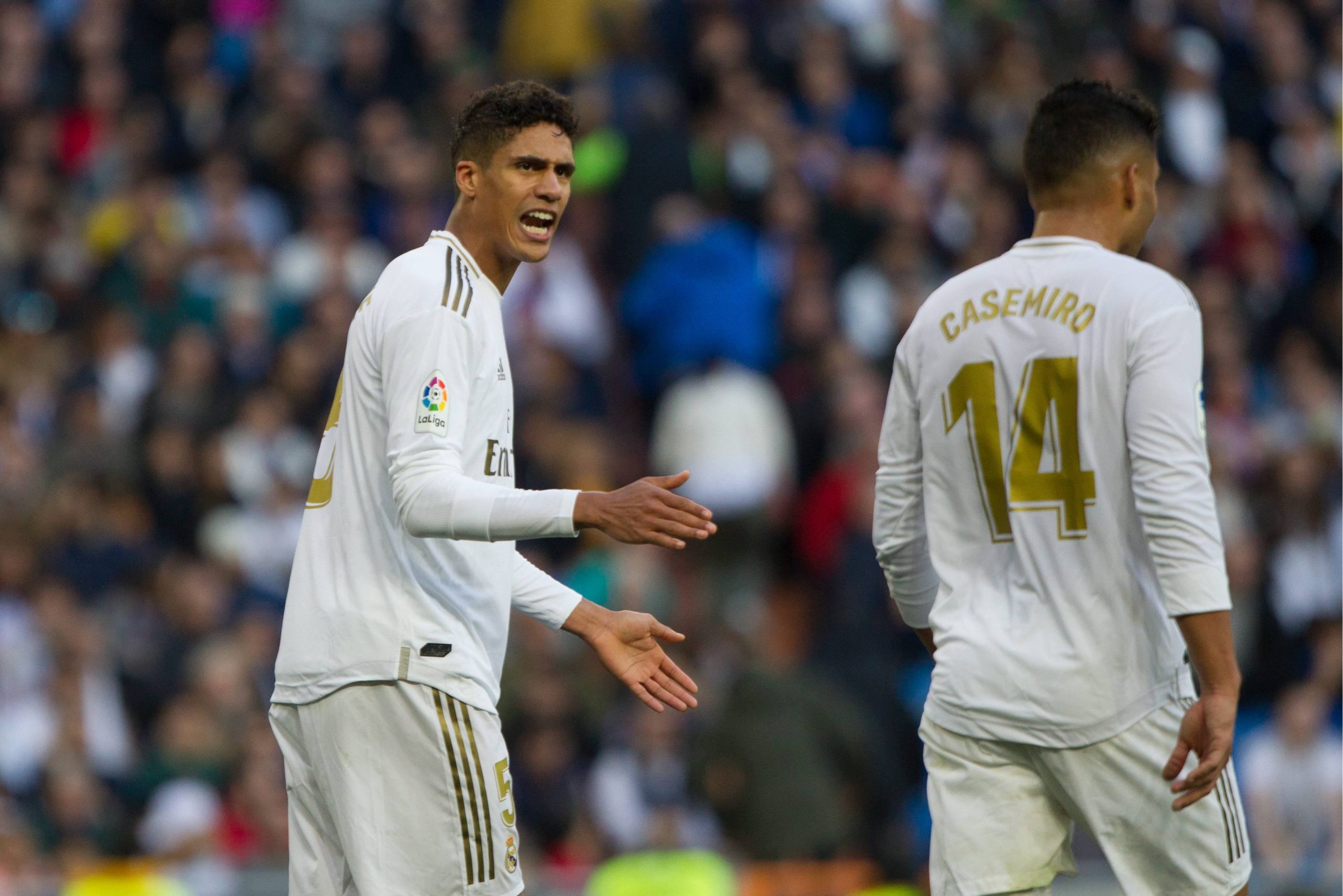Real Madrid’s stingy defence, Ansu Fati’s antecedents, the free-kick prowess of Óscar Rodríguez and Paco Alcácer’s fit at Villarreal. It’s all here in this week’s La Liga wrap.
Solid Real Madrid
Real Madrid retained their three-point advantage at the top of the table with a 1–0 victory over local rivals Atlético Madrid, a win that provides a perfect microcosm of their approach this season. Madrid took 16 shots, right on their league-high average of 15.91, but most were of relatively poor quality. They and Barcelona are pretty much dead even in terms of expected goals (xG) this season, but the two got there in very different ways: Madrid prioritise volume over quality; Barcelona take fewer shots of higher average quality.  Five of those shots came from set pieces, where Real Madrid lead the league.
Five of those shots came from set pieces, where Real Madrid lead the league. 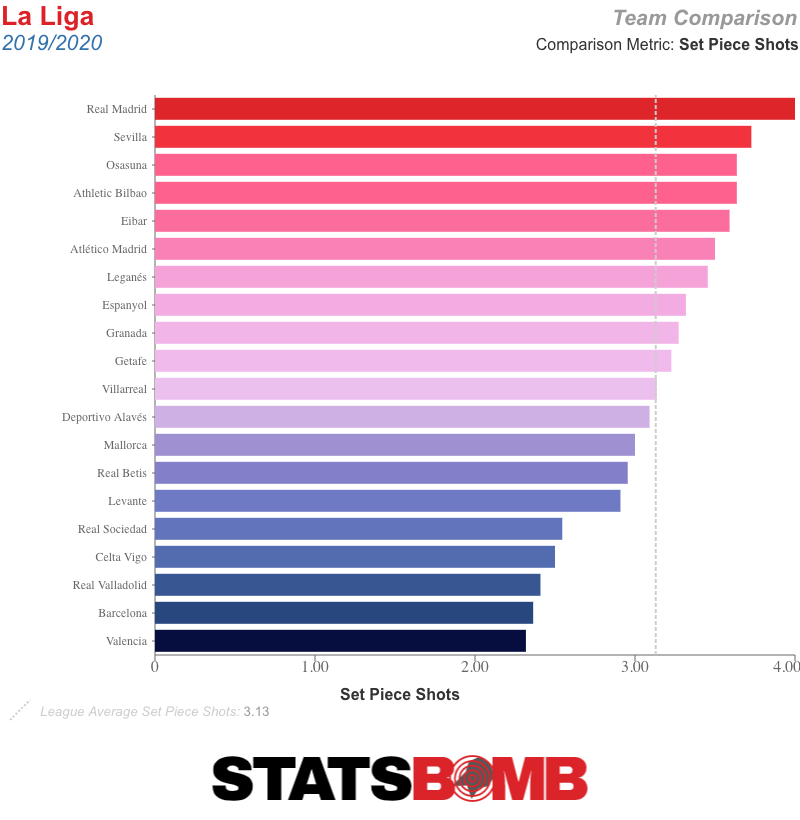 At the other end, they conceded just four shots for a tally of 0.20 xG. On average this season, only Getafe’s hyper-press has limited opponents to fewer shots than Madrid. No team has conceded fewer goals, and in xG terms, Madrid also have the league’s joint-best defence, alongside their city rivals.
At the other end, they conceded just four shots for a tally of 0.20 xG. On average this season, only Getafe’s hyper-press has limited opponents to fewer shots than Madrid. No team has conceded fewer goals, and in xG terms, Madrid also have the league’s joint-best defence, alongside their city rivals. 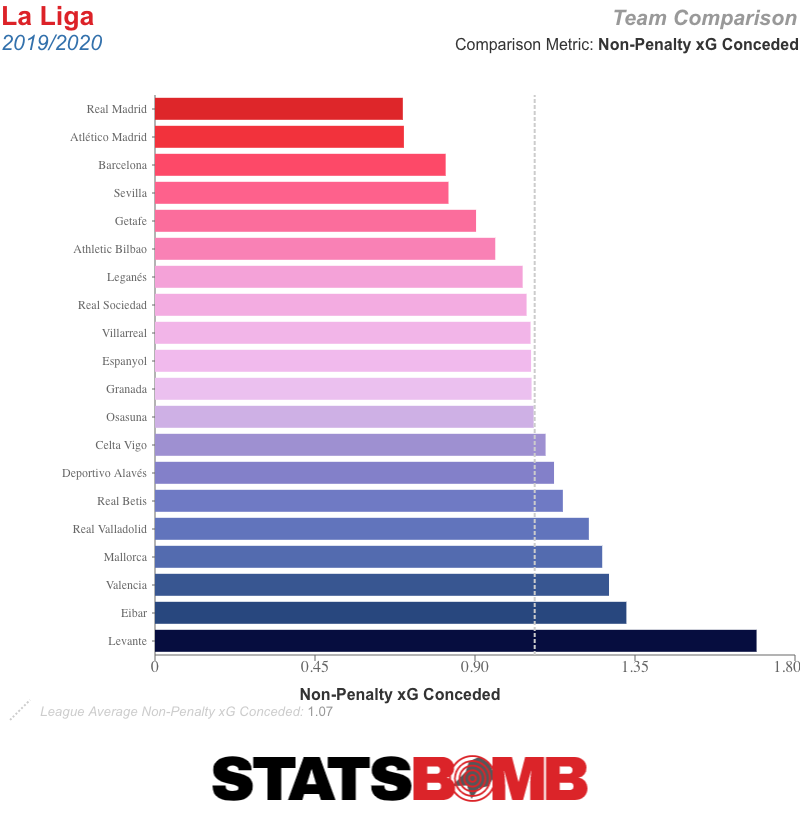 After what was, at least in their terms, a pretty disastrous campaign last time around, Zinedine Zidane has crafted a solid side capable of constricting their opponents and then piling on enough shots from crosses, set pieces and general play to more often than not get the goals they need to emerge victorious.
After what was, at least in their terms, a pretty disastrous campaign last time around, Zinedine Zidane has crafted a solid side capable of constricting their opponents and then piling on enough shots from crosses, set pieces and general play to more often than not get the goals they need to emerge victorious. 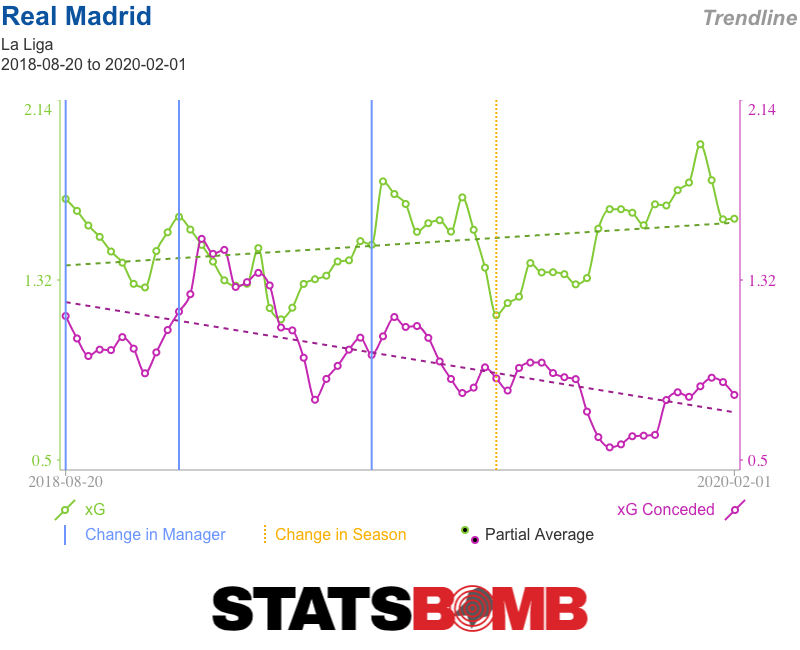 If Madrid continue to score at their current rate, they could reach 70 goals — better than last season, yet miles away from their average of over 100 goals per season over the previous five campaigns. But even if their concession rate slackens somewhat, this will still be their best defensive season since the late eighties, perhaps even further back than that. It’s a combination that may well be enough to see the league title return to the Bernabéu.
If Madrid continue to score at their current rate, they could reach 70 goals — better than last season, yet miles away from their average of over 100 goals per season over the previous five campaigns. But even if their concession rate slackens somewhat, this will still be their best defensive season since the late eighties, perhaps even further back than that. It’s a combination that may well be enough to see the league title return to the Bernabéu.
How good is Ansu Fati?
On Sunday night, Ansu Fati added another record to his growing collection by becoming the youngest-ever player to score a brace in La Liga. Two quick-fire goals, both assisted by Lionel Messi, powered Barcelona to a 2–1 win over Levante and continued his incredible ascension. “This is all a dream,” he admitted afterwards. Fati’s output to date is crazy good for a 17-year-old. 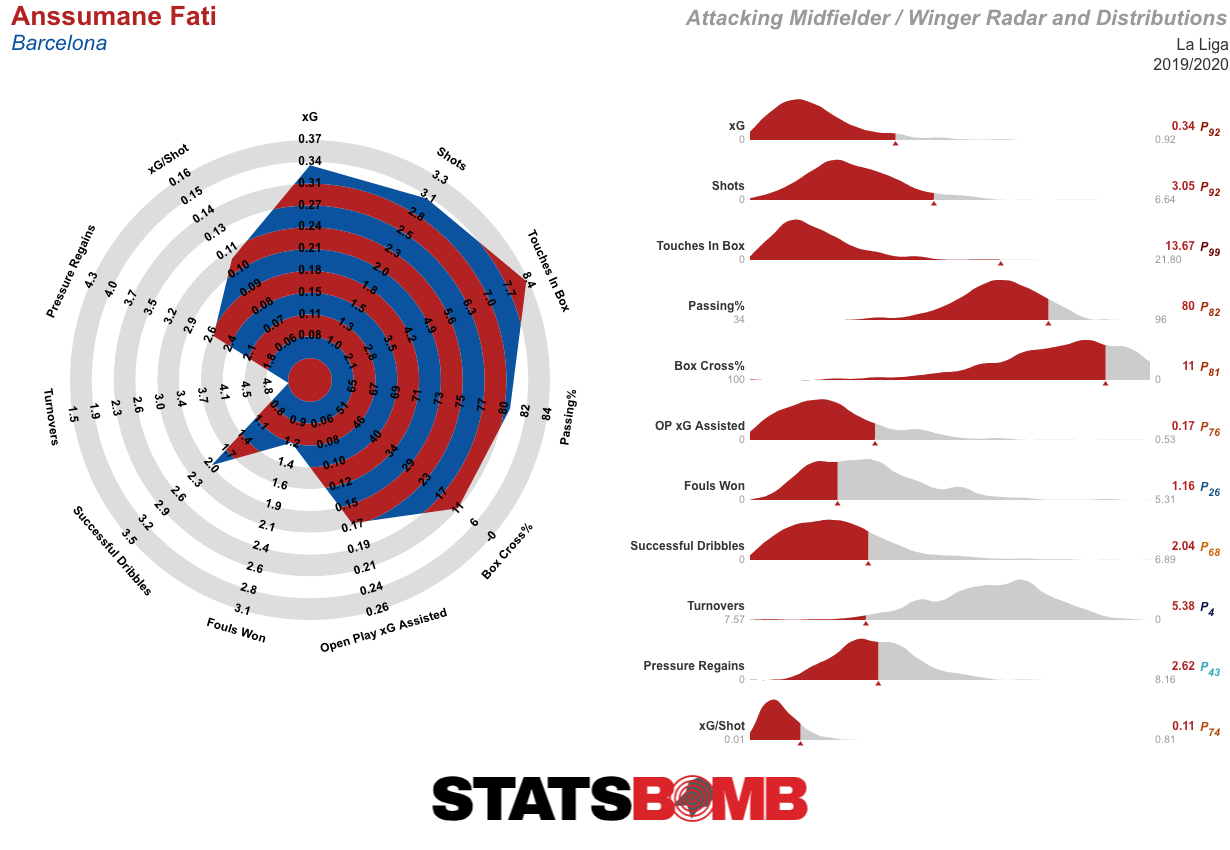 No one likes to put limits on young talents, especially ones who break through at one of the world’s biggest clubs at such a preternatural age, but two lingering questions remain: 1) Can he replicate that output over a larger sample size? Usually, a player needs to see at least 900 minutes of action before any sort of useful conclusions can be drawn about a player, and ideally more than that; and 2) How does he compare to other forwards who’ve broken through young at Barcelona? Does this kind of output necessarily precede superstardom? Thanks to our Messi Data Biography, we can answer that second question. Here is how Fati compares to several of the other starlets who’ve made strong early impressions at Barcelona. First up, the man himself: Lionel Messi.
No one likes to put limits on young talents, especially ones who break through at one of the world’s biggest clubs at such a preternatural age, but two lingering questions remain: 1) Can he replicate that output over a larger sample size? Usually, a player needs to see at least 900 minutes of action before any sort of useful conclusions can be drawn about a player, and ideally more than that; and 2) How does he compare to other forwards who’ve broken through young at Barcelona? Does this kind of output necessarily precede superstardom? Thanks to our Messi Data Biography, we can answer that second question. Here is how Fati compares to several of the other starlets who’ve made strong early impressions at Barcelona. First up, the man himself: Lionel Messi. 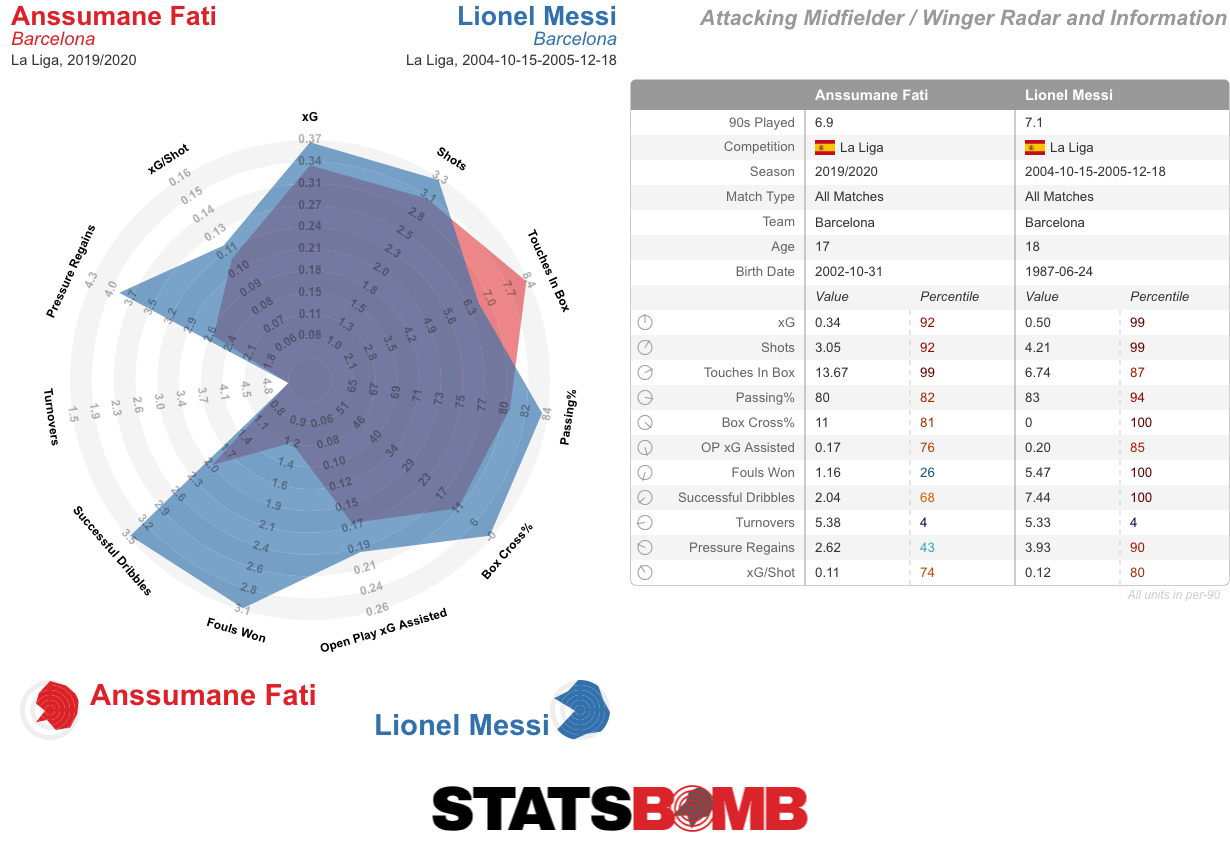 That’s probably an unfair comparison for anyone. Messi’s output was extraordinary from the get-go. Next up, Bojan. He debuted in September 2007, less than three weeks after his 17th birthday.
That’s probably an unfair comparison for anyone. Messi’s output was extraordinary from the get-go. Next up, Bojan. He debuted in September 2007, less than three weeks after his 17th birthday. 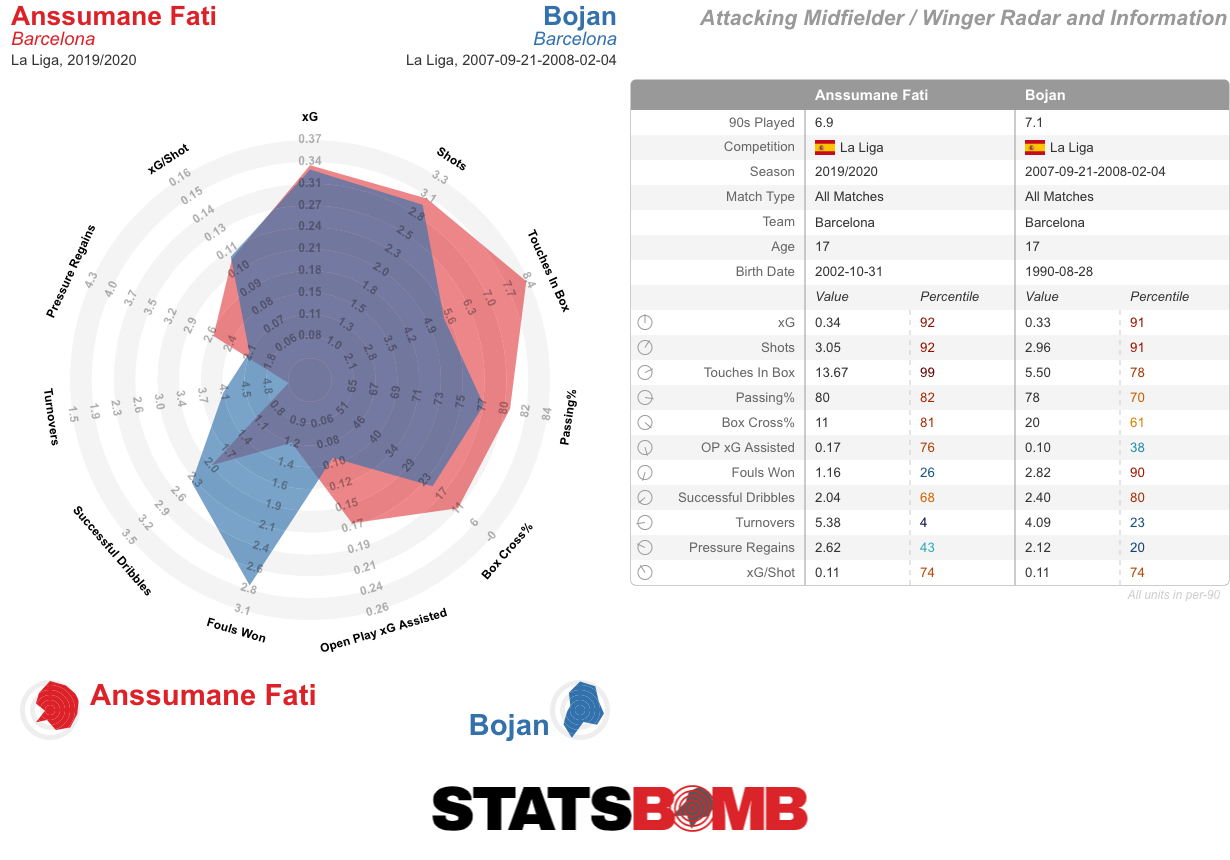 Fati just about prevails, but it’s close. Finally, we have Munir. He scored on his debut as an 18-year-old near the end of August 2014 and was a Spain international just a couple of weeks later — his one and only cap.
Fati just about prevails, but it’s close. Finally, we have Munir. He scored on his debut as an 18-year-old near the end of August 2014 and was a Spain international just a couple of weeks later — his one and only cap. 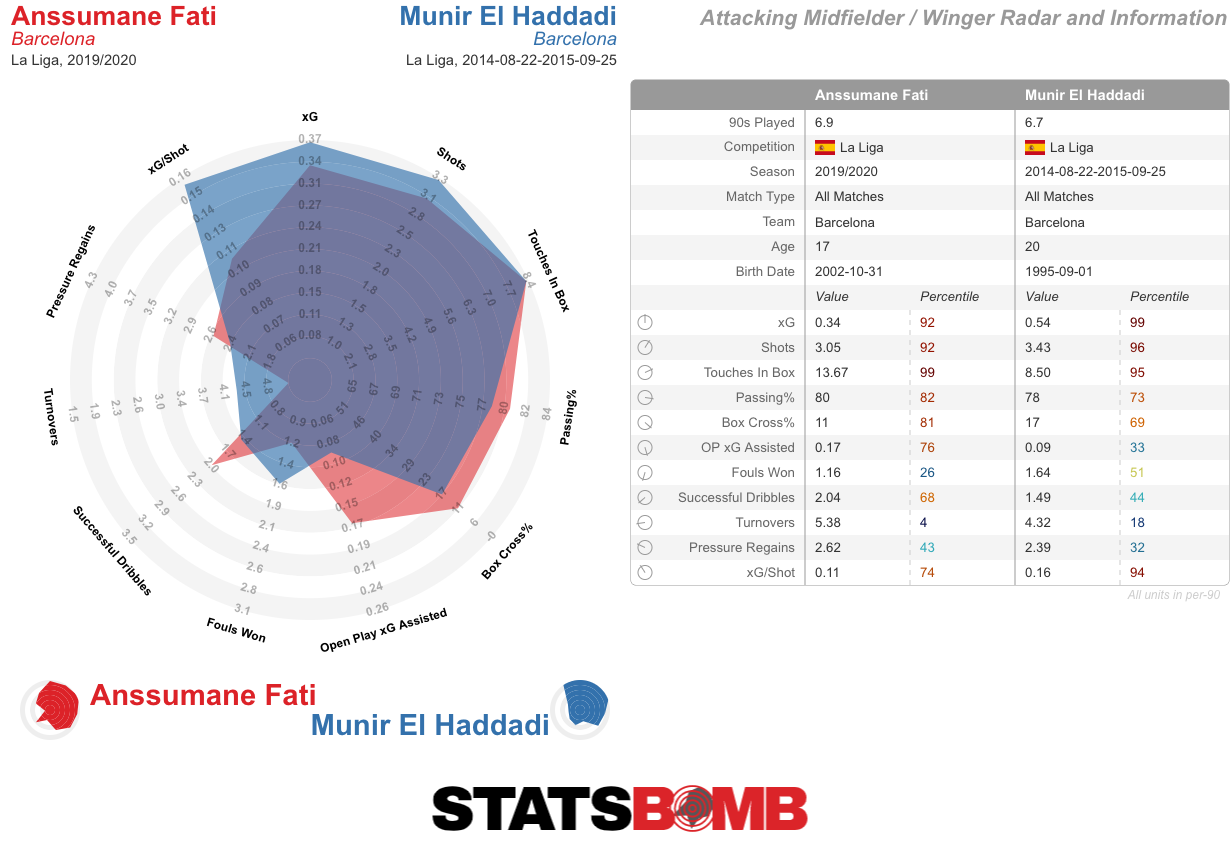 This one is pretty much a tie: better shooting output from Munir; better creative output from Fati. These quick and dirty comparisons serve to provide some context as to what Fati might go on to achieve from here. Superstar, rotational forward in a top-four chasing side or playing in MLS before age 30 — it feels like all of those outcomes are still in play.
This one is pretty much a tie: better shooting output from Munir; better creative output from Fati. These quick and dirty comparisons serve to provide some context as to what Fati might go on to achieve from here. Superstar, rotational forward in a top-four chasing side or playing in MLS before age 30 — it feels like all of those outcomes are still in play.
Óscar Rodríguez: Free-Kick Maestro?
Leganés and Real Sociedad seemed headed for a draw in their meeting at Butarque on Sunday when the home team were awarded a free-kick deep into stoppage time. Óscar Rodríguez placed the ball down and retreated a few paces. The whistle blew, and up he stepped to fire a superb strike right into the top corner.  It wasn’t the first time he’s done that this season. It was his 3rd free-kick goal from 10 attempts, and he also struck the woodwork against Valencia.
It wasn’t the first time he’s done that this season. It was his 3rd free-kick goal from 10 attempts, and he also struck the woodwork against Valencia.  So do we have a new free-kick maestro on our hands? The truth is there's no way to tell at this stage. The sample size is far too small. However, a goal scored in every three or so free-kicks is an insanely high scoring rate. Smooth it out with last season’s data, when he failed to score in 10 attempts, and the Rodríguez scores a goal in every 6.67 free-kicks, which is still quite high. Messi is one of the few players for whom there's enough data to say with a degree of confidence that he is a skilled set-piece shooter, and even he averages less than one goal in 10 free kicks over the course of his career. Over smaller sample sizes, we can see all manner of misleading hot streaks. Enis Bardhi is the go-to example in La Liga. In the 2017–18 season, he scored five goals from 16 direct free-kicks — barely less than one goal for every three he took.
So do we have a new free-kick maestro on our hands? The truth is there's no way to tell at this stage. The sample size is far too small. However, a goal scored in every three or so free-kicks is an insanely high scoring rate. Smooth it out with last season’s data, when he failed to score in 10 attempts, and the Rodríguez scores a goal in every 6.67 free-kicks, which is still quite high. Messi is one of the few players for whom there's enough data to say with a degree of confidence that he is a skilled set-piece shooter, and even he averages less than one goal in 10 free kicks over the course of his career. Over smaller sample sizes, we can see all manner of misleading hot streaks. Enis Bardhi is the go-to example in La Liga. In the 2017–18 season, he scored five goals from 16 direct free-kicks — barely less than one goal for every three he took. 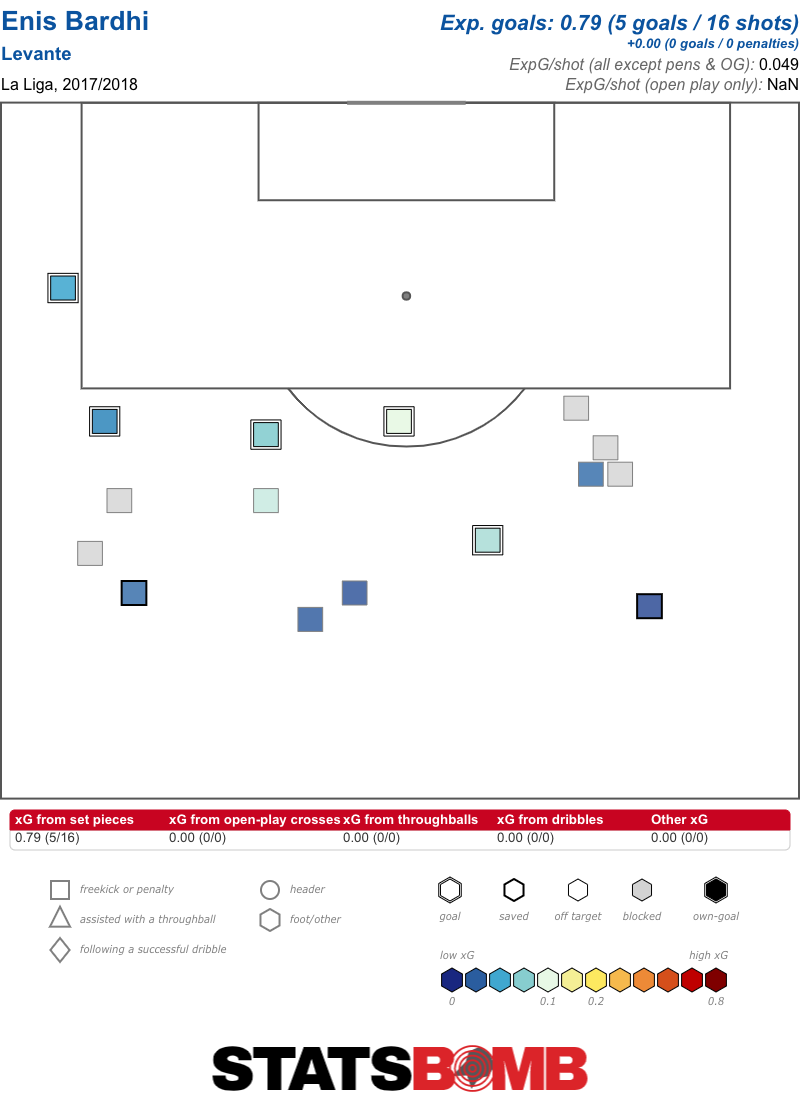 In reality, that conversion rate was never going to be sustainable. But what was, in effect, a statistical aberration was widely treated as evidence of supreme ability. Bardhi was hailed as a challenger to Messi’s crown as Europe’s best at free-kicks. Fast forward a season and a half, and the folly of that argument is evident. From his subsequent 26 shots from direct free-kicks, he has scored just once.
In reality, that conversion rate was never going to be sustainable. But what was, in effect, a statistical aberration was widely treated as evidence of supreme ability. Bardhi was hailed as a challenger to Messi’s crown as Europe’s best at free-kicks. Fast forward a season and a half, and the folly of that argument is evident. From his subsequent 26 shots from direct free-kicks, he has scored just once. 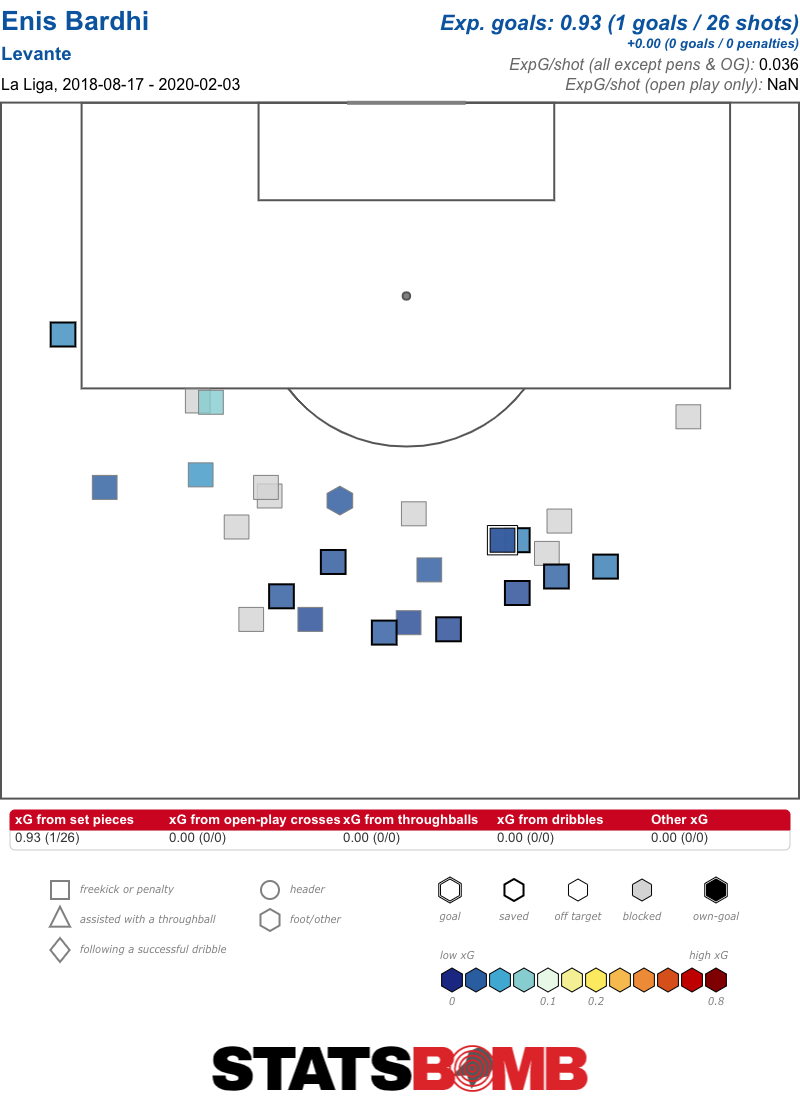 Bardhi still has an impressive but slightly more realistic hit-rate of a goal for every seven direct free-kicks he has attempted in La Liga. He is probably an above-average taker, but the evidence still only amounts to less than 50 shots. Messi has maintained an impressive rate over more than 350. Rodríguez has a long way to go to match either of them.
Bardhi still has an impressive but slightly more realistic hit-rate of a goal for every seven direct free-kicks he has attempted in La Liga. He is probably an above-average taker, but the evidence still only amounts to less than 50 shots. Messi has maintained an impressive rate over more than 350. Rodríguez has a long way to go to match either of them.
Paco Alcácer Debuts In Style
Paco Alcácer’s debut for Villarreal didn’t quite match the one of his replacement at Borussia Dortmund, but it did give an early indication that he'll be well-suited to the style of play at his new club. He moved in behind onto a Manu Trigueros pass to give them a first-half lead at home to Osasuna on Sunday, and later won the penalty from which they wrapped things up in a 3–1 win, again springing in behind before being taken down. Villarreal were already one of the most dangerous teams in La Liga in terms of moving forward in transition and getting in behind opposing defences. They lead the league in counter-attacking shots and rank in the top three for clear shots (essentially those that are one-on-one with the goalkeeper). 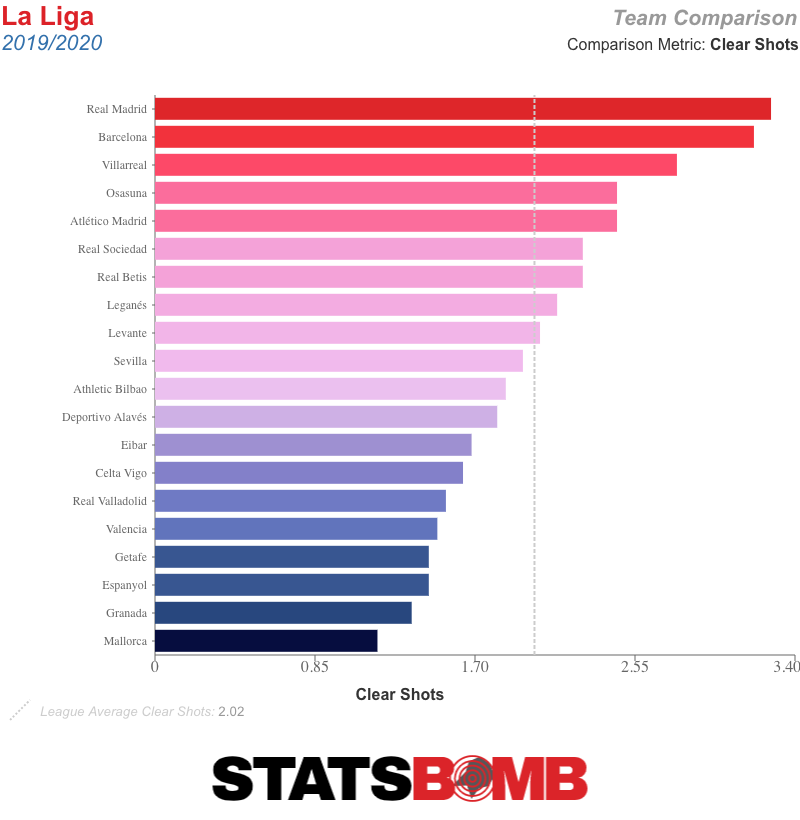 They’ve got pace in behind, and plenty of good passers. Even the two central defenders Raúl Albiol and Pau Torres — both in the top three in the league in terms of completed long balls — sometimes get in on the act, as this map of their key passes demonstrates.
They’ve got pace in behind, and plenty of good passers. Even the two central defenders Raúl Albiol and Pau Torres — both in the top three in the league in terms of completed long balls — sometimes get in on the act, as this map of their key passes demonstrates. 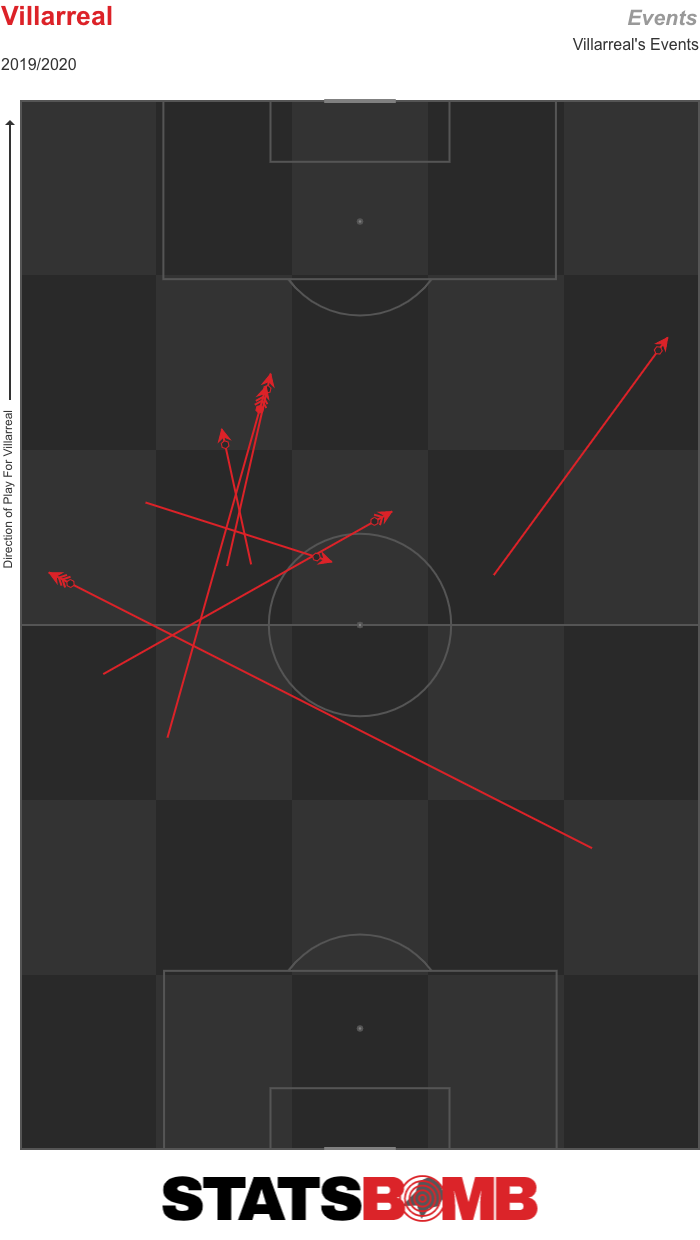 It is an environment in which a player with Alcácer’s smarts can be expected to thrive. Header image courtesy of the Press Association
It is an environment in which a player with Alcácer’s smarts can be expected to thrive. Header image courtesy of the Press Association
